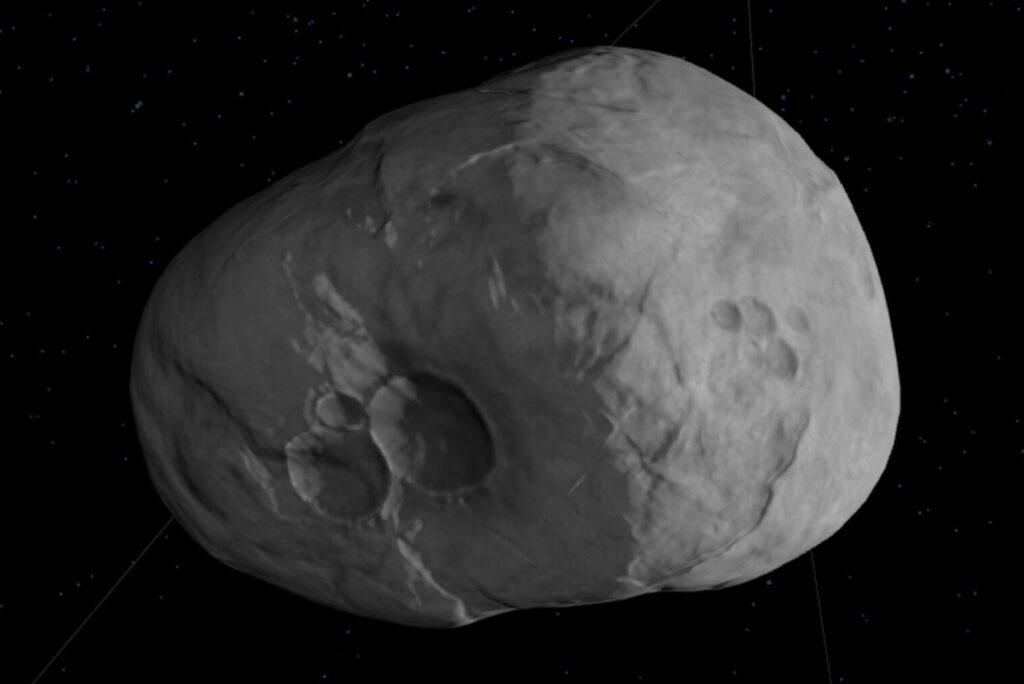Asteroid 2023 DW (dubbed the Valentine’s Asteroid by many) isn’t expected to potentially hit the Earth until 2046. But that’s still a little too close for comfort for many people. Although the chances are still slim, they seem to be continually increasing each time the experts reassess the asteroid’s path. So if this 50-meter-in-diameter asteroid were to hit the Earth, how bad would it be?
The Asteroid Is Similar in Size to the One that Caused the Tunguska Event

2023 DW is about the size of the asteroid that caused the Tunguska event. That asteroid was estimated to be about 50 to 60 meters in size and is estimated to have caused a 12-megaton explosion in 1908. It flattened 80 million trees over 830 square miles. Hundreds of reindeer died. What makes this so unique is that it’s the only modern large asteroid impact that we can look back on.
For comparison, 2023 DW is currently estimated to be a little over 50 meters in diameter.
NASA reported on the Tunguska Event at its 100-year anniversary, sharing that a man in Siberia 40 miles away from ground zero was hurled from his chair and felt as if his shirt was on fire because the heat was so strong from the impact.
Seismic waves were registered all the way in England, NASA shared. People from Asia reported being able to read newspapers outside at midnight because of how the night skies were glowing from the impact.
Interestingly, there was no impact crater. Experts believe this is because pressure and heat as it entered the atmosphere caused it to basically self-explode and release a fireball. So there was no crater, but there was still an energy release “equivalent to about 185 Hiroshima bombs,” NASA noted.
So based on Tunguska, it’s possible that an impact from the Valentine’s asteroid would yield huge amounts of damage in the immediate area (perhaps up to 800 square miles or more), but it wouldn’t be a world-ending apocalyptic event.
The Planetary Defense Coordination Office Warns That 50 Meters Is Large Enough to Cause ‘Significant Damage’
However, as Science Alert warned, you can only get rough predictions of destructive capability by comparing similarly sized asteroids. Where it hits, the impact angle, and the speed of the asteroid can all affect the outcome. Tunguska exploded in the atmosphere, which also might have changed the outcome quite significantly.
NPR reported that a similar-sized object might have also been the cause of a meteor crater in Arizona that hit 50,000 years ago.
In fact, NASA’s Planetary Defense Coordination Office specifically tracks asteroids starting at 30 to 50 meters due to their damage potential. The site notes that PDCO “provides early detection of potentially hazardous objects (PHOs) – the subset of NEOs whose orbits predict they will come within 5 million miles of Earth’s orbit; and of a size large enough (30 to 50 meters) to cause significant damage on Earth.”
Two Scales Are Used to Rank Asteroids’ Hazard Potential
NPR reported that there are two scales used to rank the possible hazard potential of an asteroid. One is the Torino Scale by NASA and one is the Palermo Scale — a newer scale that can be seen on the European Space Agency’s (ESA’s) site.
The 2023 DW asteroid is ranked 1 on the Torino Scale (with it needing to reach 3 for a 1% chance of “localized destruction”), Science Alert noted. That indicates little chance of destroying humanity. NPR reported that a 1 value is a “routine” near-Earth pass that wouldn’t pose an unusual level of danger.
NASA explains the Torino Scale here. 1 is color-coded green and indicates newer observations will “very likely lead to re-assignment to Level 0.” After that it goes all the way up to 10. 2-4 are color-coded lime/yellow or “meriting attention by astronomers.” Levels 5-7 are orange or “threatening.” And levels 8-10 are red or “certain collisions.” As stated before, 2023 DW is currently green.
NASA lists all the current objects being monitored on its Sentry Page here. Everything on that list has a Torino Scale of 0 except 2023 DW, which has a Torino Scale of 1.
As for the Palermo Scale, NPR notes that this one is logarithmic. NASA notes: “Actual scale values less than -2 reflect events for which there are no likely consequences, while Palermo Scale values between -2 and 0 indicate situations that merit careful monitoring. Potential impacts with positive Palermo Scale values will generally indicate situations that merit some level of concern.”
The scale compares the chance of a potential impact with the “background risk” or average risk of objects of that same size or larger over the years. So a -2 ranking “indicates that the detected potential impact event is only 1% as likely as a random background event occurring in the intervening years.”
You can see the Palermo scale risks on ESA’s website here. 2023 DW sits at -2.00 as of the time of this article’s publication (when NPR reported about it on March 10, the risk was -2.17, so it’s increased slightly. Remember: the closer to zero, the greater the risk.) Only three objects are greater than -3 on the scale, and 2023DW is the greatest of the bunch. (This same chart also lists the Torino Scale list right next to the Palermo Scale, listed as PS max.)
It’s worth noting that two objects are included in a second chart called “Special Risk List” — 101955 Bennu at -1.59 and 29075 1950DA at -2.13. But both have a potential impact date of more than 100 years from now.
Want to chat about all things post-apocalyptic? Join our Discord server here. You can also follow us by email here, on Facebook, or Twitter.
